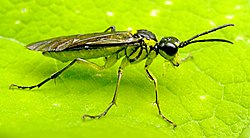Anti-predator adaptations are mechanisms developed through evolution that assist prey organisms in their constant struggle against predators. Throughout...
53 KB (5,801 words) - 16:47, 4 December 2024
Pursuit predation (redirect from Pursuit predator)
other predators are present. In addition to behavioral adaptations, there are also morphological anti-predator adaptations to pursuit predators. For example...
32 KB (4,173 words) - 17:41, 26 May 2025
Predator satiation (less commonly called predator saturation) is an anti-predator adaptation in which prey briefly occur at high population densities,...
5 KB (536 words) - 15:36, 6 October 2024
a selective advantage as predators avoid the model and therefore also the mimic. Mimicry is thus an anti-predator adaptation. A common example seen in...
75 KB (8,239 words) - 16:45, 23 May 2025
Predation (redirect from Predator (biology))
has a powerful selective effect on prey, and the prey develops anti-predator adaptations such as warning colouration, alarm calls and other signals, camouflage...
107 KB (11,425 words) - 16:23, 1 June 2025
Mobbing (animal behavior) (category Antipredator adaptations)
Mobbing in animals is an anti-predator adaptation in which individuals of prey species cooperatively attack or harass a predator, usually to protect their...
24 KB (2,690 words) - 18:29, 22 May 2025
Matutinal (section Anti-predatory adaptation)
prevalence of food during these hours. It may also serve as an anti-predator adaptation by allowing animals to sit between the brink of danger that may...
15 KB (1,714 words) - 05:11, 18 November 2024
of adaptation that promotes the survivability of an organism by protecting it from its natural enemies, such as predators (Anti-predator adaptation) or...
498 bytes (99 words) - 21:30, 19 July 2017
good reduces the worth of each individual unit of it Predator satiation, an anti-predator adaptation involving high population densities of the prey Semantic...
604 bytes (102 words) - 18:11, 13 February 2022
remove a substance on the ant. Ants produce formic acid as an anti-predator adaptation. Thus, when an ant feels threatened, as when in the beak of a bird...
11 KB (1,333 words) - 19:19, 16 May 2025
Phasmatodea (section Anti-predator adaptations)
fact being animals. Their natural camouflage makes them difficult for predators to detect; still, many species have one of several secondary lines of...
53 KB (6,109 words) - 15:05, 25 May 2025
Seed predation (redirect from Seed predator)
seed predators. Adaptations to defend seeds against predation can impact seeds' ability to germinate and disperse. Thus anti-predator adaptations often...
18 KB (2,241 words) - 18:37, 23 January 2025
Chameleon (section Anti-predator adaptations)
whereas anti-predator camouflage colour changes have decreased relative to the native source population in Kenya where there are more predators. Chameleons...
60 KB (6,286 words) - 10:19, 24 May 2025
Extatosoma tiaratum (section Anti-predator adaptations)
a defensive odor reminiscent of toffee. Males may attempt to startle predators by flashing their wings open. E. tiaratum makes use of both passive and...
14 KB (1,377 words) - 11:03, 26 April 2025
Oarfish (section Predators and parasites)
practise autotomy, self-amputating the tail, presumably as an anti-predator adaptation. All captured R. russellii over 1.5 m long have autotomized tails;...
28 KB (2,947 words) - 06:02, 23 May 2025
Orussoidea are parasitic. Predators include birds, insects and small animals. The larvae of some species have anti-predator adaptations such as regurgitating...
56 KB (6,090 words) - 04:00, 21 May 2025
glands that contain a powerful nerve poison, tetrodotoxin, as an anti-predator adaptation. Throughout much of the newt's range, the common garter snake is...
21 KB (2,524 words) - 08:57, 9 April 2025
Beetle (section Anti-predator adaptations)
Beetles use a variety of anti-predator adaptations to defend themselves. These include camouflage and mimicry against predators that hunt by sight, toxicity...
156 KB (17,079 words) - 15:29, 2 June 2025
Eurycnema goliath (section Anti-predator adaptations)
swaying of leaves and branches. This adaptation assists the goliath stick insect in avoiding detection by predators. In response to being attacked or disturbed...
23 KB (2,555 words) - 16:44, 23 May 2025
Deimatic behaviour (category Antipredator adaptations)
deimatic and aposematic, if it both startles a predator and indicates the presence of anti-predator adaptations. Vertebrates including several species of frog...
23 KB (2,545 words) - 08:01, 18 November 2024
Barnacle (section Predators and parasites)
Their hard shells are assumed by zoologists to have evolved as an anti-predator adaptation. One group of stalked barnacles has adapted to a rafting lifestyle...
50 KB (4,786 words) - 10:02, 24 May 2025
"A speciation gene for left-right reversal in snails results in anti-predator adaptation". Nature Communications. 1 :133. Ota H, Lin JT, Hirata T, Chen...
16 KB (1,799 words) - 11:44, 25 May 2025
Hunting success (section Social and solitary predators)
harvest susceptibility. Pursuit predation Pack hunting Trophic level Anti-predator adaptation A. V. Shubkina, Aleksey Sergeevich Severtsov, K V Chepeleva (February...
37 KB (4,341 words) - 10:56, 24 May 2025
from planktivorous fish, implying that the mechanism may be an anti-predator adaptation. Development begins with a bilaterally symmetrical embryo, with a...
113 KB (11,329 words) - 06:50, 2 June 2025
Slime coat (section As a defensive adaptation)
serves as an anti-predator adaptation: when grabbed by a predator fish, the hagfish ejects copious amounts of slime into the predator's mouth, causing...
12 KB (1,249 words) - 15:15, 23 May 2025
lengths as needed. For these freshwater snails, the siphon is an anti-predator adaptation. It reduces their vulnerability to being attacked and eaten by...
12 KB (1,313 words) - 22:22, 30 December 2024
this movie, inspired from biology of real-life creatures such as anti-predator adaptation of bombardier beetle and poison glands of vipers, was used in later...
22 KB (2,148 words) - 13:43, 28 May 2025
and has been especially frequently discussed with relation to anti-predator adaptations. Frequency-dependent selection can lead to polymorphic equilibria...
12 KB (1,355 words) - 11:26, 18 February 2025
was removed it was assumed a bird predator had taken it: this could be distinguished from visits by other predators. They found that disruptive coloration...
26 KB (2,757 words) - 03:12, 19 May 2025
elements and from predators, with some animals having features such as spines or camouflage serving exclusively as anti-predator adaptations. Many animals...
9 KB (896 words) - 09:04, 3 May 2025
























